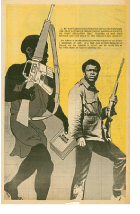Emory Douglas's imagery will have lodged itself somewhere in your mind. His responsibility became to find a method of involving as many people as possible in a cause and who knows if the message of the BPP would have impacted without the strident, striking but humane imagery he consistently invented. Inspired by Cuban artists he concentrated on universal images of struggle but did not give his characterisations a glorious façade. He didn't create heroes but empowered people with the belief that just being true to a cause is heroic.
He was the designer of the party's paper, displayed his work in ghettos were illiteracy would have made the paper less potent and became their minister of culture in later years. His artwork would have lived on if he had been a mere commentator of the times, but the fact that he was as involved as directly as any member of the party, and under consistent threats to his life, makes it an extraordinary story.
Urbis have covered so much of the times and the man that it could have been too dense a subject to take in, but relevant pieces, imagery and messages are given the right level of prominence and draw you into the finer details of an inspiring but troubling narrative.
If you have any doubts about how important the panthers and Emory Douglas's work is then the opening section graphically displays a history of horrific violence to a people that is hard to take in, and importantly does not assign the crimes to a time and a place. That it is brave enough to echo these horrors in so much of the world we still live in shows great respect and sensitivity to Douglas and the people who inspired him and were inspired by him. This includes pretty much everyone I saw entranced by this exhibition.

 It is unusual to walk around a gallery that does so little to debate or impress upon you the aesthetic nature of the artist. Urbis's brilliant Emory Douglas retrospective is, however, an incredible testimony to the power of his work, and the fact that they have understood that it can't be understood outside of his passions makes the exhibition itself a stunning experience.
It is unusual to walk around a gallery that does so little to debate or impress upon you the aesthetic nature of the artist. Urbis's brilliant Emory Douglas retrospective is, however, an incredible testimony to the power of his work, and the fact that they have understood that it can't be understood outside of his passions makes the exhibition itself a stunning experience. 